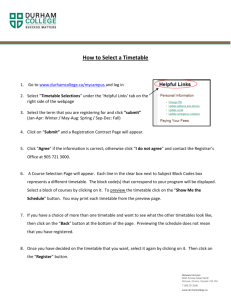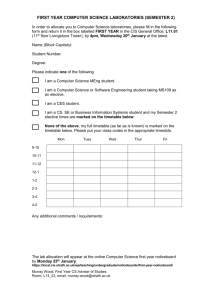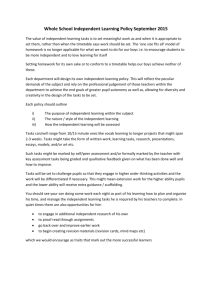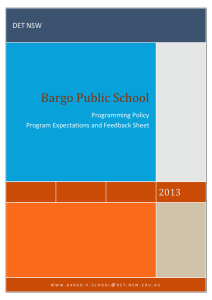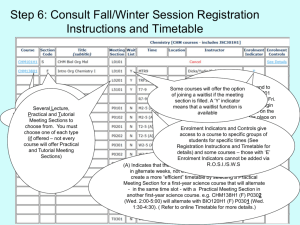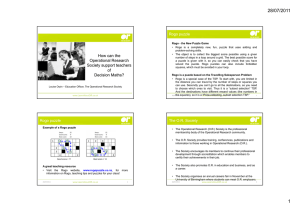Communications Studies and Personal Development
advertisement
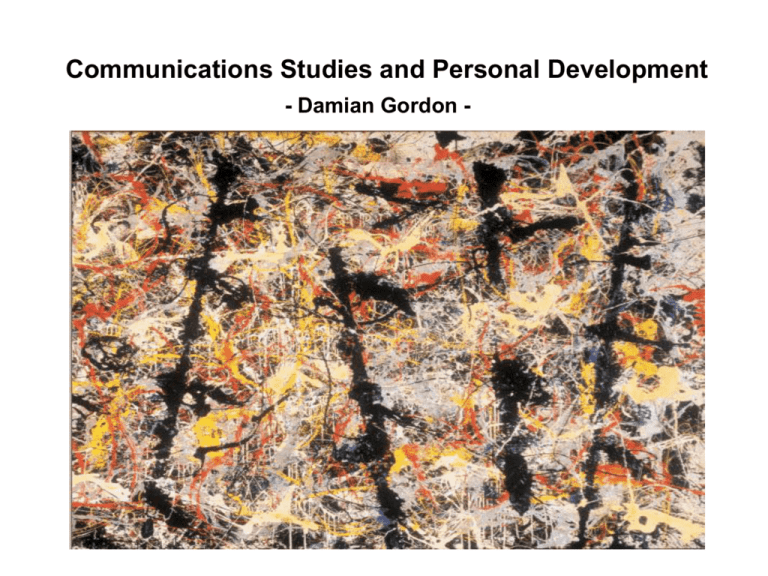
Communications Studies and Personal Development - Damian Gordon - Module Aim • This module will introduce students to the theory of clear communication and to a range of practical communication skills. These skills will include writing basic technical and business documents, delivering oral presentations, studying effectively, networking productively, listening actively and participating fully in team projects. Module Description 1. Improve the students’ academic performance, their career prospects, and ultimately their companies’ success through clear, concise, ethical and accurate communication. 2. To develop the students’ critical thinking abilities, their social and interactive skills, their understanding of the principles underpinning communication problems, and a positive approach to communicating clearly in a diverse range of situations. 3. To reinforce students’ self-esteem through a greater understanding of communication principles and their practice of a range of valuable communication skills Learning Outcomes 1. plan, draft and edit a wide range of basic business and technical documents, including reports, letters, instructions, specifications, memoranda and e-mail. 2. make formal oral presentations, using appropriate visual aids; to contribute effectively to group interaction and performance 3. discuss contemporary communication issues in organisations such as the role of new information technologies, intercultural communication, globalisation and legal and ethical issues. 4. apply appropriate study skills to bridge the gap from second level and third level 5. use appropriate technical skills for written deliverables 6. use more effectively communication skills such as questioning and listening skills, study skills, intercultural competencies and nonverbal interaction. Module Content (1/6) • Introduction to Principles of Communication: Categories of human communication; importance of effective communication for studies and career; role of communication in organisations; how the components of the communication process work; ways to improve interpersonal communication. Module Content (2/6) • Effective Writing: Planning and drafting a document; revising, editing and proof-reading documents; organising information; layout, format and structure of various documents; style of writing including references to tone, word choice, sentence structures; review of most important principles of grammar and punctuation; writing products including reports, technical documents, letters and e-mails; using the computer in writing projects; writing a curriculum vitae; note-taking and basic research. Module Content (3/6) • Oral Presentation: Major steps in preparing an oral presentation; verbal and non-verbal aspects of delivering a presentation; structuring a presentation; criteria for evaluating presentations; use of visual aids; basics of interview techniques. Module Content (4/6) • Interpersonal and Organisational Communication Skills: Communicating in teams: listening skills; participating more effectively at meetings; the vocabulary of meetings and roles of committee personnel; handling conflict at meetings; the categories and functions of nonverbal communication and its role in effective communication; giving effective feedback . Module Content (5/6) • Contemporary Issues in Communication: Information technology and its implications for individual and organisational communication; globalisation and intercultural communication; legal and ethical aspects of communication; autonomy in work; rate of change and its implications for communication Module Content (6/6) • Personal development: Study skills, technical writing Assessment • The Module is assessed as 100% Continuous Assessment. How to write e-mails How to write an e-mail • Writing e-mails is a skill • It takes practice • With email, you can't assume anything about a sender's location, time, frame of mind, profession, interests, or future value to you. This means, among other things, that you need to be very, very careful about giving your receivers some context. How to write an e-mail Subject Line Need help with timetable Re: Need help with timetable Fwd: Need help with timetable URGENT: Need help with timetable REQ: Need help with timetable FYI: Need help with timetable How to write an e-mail Mr./Ms. [Full name], [Body of e-mail]. Regards, Your name Student Number DT211/1 How to write an e-mail Quoting an e-mail > I am e-mailing you to request if you > you have finished it yes How to write an e-mail Change pronouns > I am e-mailing you to request if you > you have finished [the assignment] yes How to write an e-mail • Short Paragraphs – Frequently email messages will be read in a document window with scrollbars. While scrollbars are nice, it makes it harder to visually track long paragraphs. Consider breaking up your paragraphs to only a few sentences apiece. How to write an e-mail • Line Length – Some mail clients do not automatically wrap (adjust what words go on what line). This means that if there is a mismatch between your client's and your correspondent's in how they wrap lines, your correspondent may end up with a message that looks messy. – You should try to keep your lines under sixty characters long. This is to leave a little room for the indentation or quote marks your correspondents may want if they need to quote pieces of your message in their replies. How to write an e-mail • Smileys – A facial gestures can be represented with what is called a "smiley": a textual drawing of a facial expression. The most common are; :-) ;-) :-( How to write an e-mail • Language – The biggest status cue is your competence with the language. – If you have lots of misspellings, your subjects do not agree with your verbs, or you use the wrong word, people may assume that you are uneducated. From that, they may infer that you are not very clever. It doesn't matter that the correlation between language ability and intelligence is weak (especially among nonnative speakers); lots of people will make that inference anyway. – Furthermore, some people are literally insulted by getting email with errors, especially typographical errors. They feel that it is disrespectful to send email with blatant errors. (Note that you can use this to your advantage. If you want to flaunt your superior status, you can insert some typos deliberately.) How to write an e-mail • Acronyms – – – – – – – BTW - By The Way FYI - For Your Information IMHO - In My Humble/Honest Opinion RTFM - Read The Manual ("Manual" here refers to any documentation) LOL - [I] Laughed Out Loud [at what you wrote] RSN - Real Soon Now ROTFL - [I am] Rolling On The Floor Laughing [at what you wrote] • These are less common, but show up occasionally: – TTFN - Ta-Ta For Now – TIA - Thanks In Advance (also sometimes written advTHANKSance) What was that all about ? What was that all about ? • Write down the three most important ideas you encountered during the class. • Swap with the person beside you, are their top three similar or different? What was that all about ? • Have a look at the notes that you have taken, do they make sense? Write a question mark beside everything you are not sure of, and underline the key issues. • Swap with the person beside you, are their notes similar or different?
